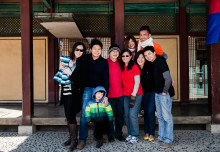“Should I check-in the carseat?”, “Should I bring it on-board”, “What is a Cares Harness” and “Should I just rent one at our destination?”
These are the common questions we’ve seen getting asked when it comes to flying with kids. Here, we’ll share our experience in the hopes that you’ll be informed to make the right choice for you and your family.
Lap Babies
We first purchased a seat for Liam when we flew to Europe with him at 6 months old. It was the best decision we’ve ever made and we’ve continued to purchase a seat for our kids ever since (most recently, Owen flew in his own seat to Korea at 4 months old). We know it’s expensive but when it comes to the safety of our children, we do the best we can and in our case, it was purchasing a seat so that they get to ride in their own carseat.
During takeoff and landing, we’re not allowed to have loose bags, hold a cup or have anything in our hands/lap because they can become flying projectiles. Why is it then babies are allowed to sit on our lap, unsecured? There are various reports, articles, opinion pieces and studies that show that your child will be safest in a carseat during air travel.
“Your arms aren’t capable of holding your child securely, especially during unexpected turbulence. The Federal Aviation Administration (FAA) strongly urges you to secure your child in a CRS or device for the duration of your flight. It’s the smart and right thing to do so that everyone in your family arrives safely at your destination. ~FAA”
If the plane makes an emergency stop during takeoff, crash lands or even if it hits serious turbulence, the unsecured babies can and do become projectiles. Of course, the risk of it happening is very very low. However, we are a stickler for safety, so a seat for Liam and a seat for Owen is a must, every time we travel.
Infant Carseats
We brought along our Chicco Keyfit30 Infant carseat for Liam when he was still traveling in it (now Owen travels in it). You can leave the base behind because on the plane, you can secure it by running the seatbelt across the top of the seat. In cars, you can secure it using the seatbelt without the need for the base (refer to your manual for instructions specific to your infant carseat).

You don’t need the infant carseat base to secure the infant carseats on board the plane or in cars as well. Refer to your carseat manual for more details specific to your infant carseat.

We’ve always installed our infant carseats rear-facing. It helps if you ask for bulkhead seat, so you don’t have the issue of annoying the passenger in the front who now has limited recline.
The carseat should be installed rear-facing just like it would in a car. From the FAA advisory circular:
Section 10. REGULATORY REQUIREMENTS REGARDING THE USE OF CRSs ON AIRCRAFT:
10b. Proper Use of CRS:
If a child occupies a CRS, a parent/guardian must accompany the child and the aircraft operator must comply with the requirements that the child is properly secured in the CRS, the CRS is properly secured in a forward-facing seat, the child does not exceed the weight limits of the CRS, and the CRS is approved and has the proper labels or markings.
Section 18. PLACEMENT OF CRS ON THE AIRCRAFT:
CRSs must be installed in forward-facing aircraft seats, in accordance with instructions on the label. This includes placing the CRS in the appropriate forward or aft-facing direction as indicated on the label for the size of the child. A window seat is the preferred location; however, other locations may be acceptable, provided the Par 16 Page 11 AC 120-87B 9/17/10 CRS does not block the egress of any passenger, including the child’s parent or guardian, to the aisle used to evacuate the aircraft.
This is often mis-interpreted by flight attendants to mean that the car seat must be forward facing. It actually just means that the airplane seat must be forward-facing, not the carseat. You may choose to install your carseat within the rear-facing limits of the seat.
You can also ask for a seatbelt extender from the flight attendants if you need to extend the seatbelt in order to install the seats.
Convertible Carseats
When Liam outgrew his infant carseat, we switched him to a Peg Perego Convertible carseat. This carseat is FAA certified and can be brought on board the plane.

We brought along our son’s convertible carseat when he outgrew his infant carseat. Since Liam was used to napping in his carseat in the car, he had no issues napping in the carseat on the plane.
Having our kids in carseats on board the plane gave us peace of mind. It also means free hands for mom and dad!
Cares Harness
I’ll be honest. With two kids, carrying on board 2 carseats made us think twice about flying. Luckily, we learned about the Cares Harness for toddlers who weigh over 22lb. This meant that we could gate-check Liam’s convertible carseat and just bring on board Owen’s infant carseat and a Cares Harness for Liam.

Cares Harness – an FAA approved, five-point harness for toddlers 22 – 44lb.

We still lugged the convertible carseat through the airport with us. We just gate-check it instead of bringing it on board.
With the Cares Harness, Liam was able to securely sit in his seat and still carry out activities such as reading, sticking stickers all over the chair, eat, drink and sleep. However, as with everything, there are pros and cons to it.
Pros:
- It’s compact and fits into a small stuff sack.
- Easy and quick to install.
- Adjusts to fit almost every size airplane seat.
Cons:
- There’s no strap between the legs, so a child could wriggle/slide their way down the seat. (Without the Cares Harness, the child would be using the lap belts as is and can slide their way down the seat anyhow).
- Child’s head ends up resting on the strap that goes horizontal behind their head. It can be a little uncomfortable. So for Liam, we’ve sometimes draped a layer of blanket over it as cushioning.
- It requires putting down the tray table of the passenger behind you during installation.
- It’s pricey.

Liam’s head ends up resting on the strap that goes horizontal behind his head. It can be a little uncomfortable. So for Liam, we’ve sometimes draped a layer of blanket over it as cushioning.
I’d highly recommend watching this video and getting yourself familiar with the installation before your first use on a flight. Also, locate the FAA approval tag ahead of time to show flight attendants if they ask.
Some flight attendants tell you that you can’t use your car seat on the plane?
Not all carseats are approved for airplane use. Check the sides of your carseat for these exact words “This child restraint is approved for use in motor vehicles and aircraft”. Check before you head to the airport!
If your carseat is approved for use aboard a aircraft, then the airline (that is governed by FAA), MUST allow you to use it as per the following regulation:
Section 10. REGULATORY REQUIREMENTS REGARDING THE USE OF CRSs ON AIRCRAFT:
10d. Regulations:
Under the provisions in parts 121, 125, and 135, no certificate holder may prohibit a child from using an approved CRS when the parent/guardian purchases a ticket for the child. (Certificate holders are encouraged to allow the use of empty seats to accommodate CRS; however, they are not required to allow unticketed children to occupy empty passenger seats, even if the child uses a CRS.)
If your carseat doesn’t fit, they must move you to a seat where it does. If your rear-facing carseat interferes with the row in front, they must move you to one where it doesn’t, move the person in front to another seat so they can recline or the person in the front just have to accept that they will not be able to recline.
10f. Operators Prohibiting CRS Use:
No aircraft operator may prohibit a child from using an approved CRS when the parent/guardian purchases a seat for the child. If an approved CRS, for which a ticket has been purchased, does not fit in a particular seat on the aircraft, the aircraft operator has the responsibility to accommodate the CRS in another seat in the same class of service. The regulations also permit an aircraft operator to use its discretion in identifying the most appropriate forward-facing passenger seat location, considering safe operating practices. For example:
(1) A CRS with a base that is too wide to fit properly in a seat with rigid armrests can be moved to a seat with moveable armrests that can be raised to accommodate the CRS.
(2) An aft-facing CRS that can not be installed properly, because of minimal pitch (distance between seats) between rows, can be moved to a bulkhead seat or a seat in a row with additional pitch.
You can print this out if you need (FAA advisory circular about the use of child restraint systems)
Here’s another good post about your rights when it comes to flying with a carseat.
See here for more tips from us about flying with infants and toddlers.




